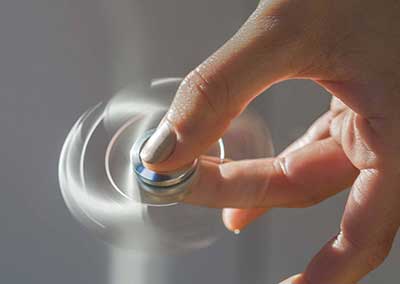
What’s Up With The Fidget Spinner?
“Hey, check out my new fidget spinner! It has red and blue lights!”, “Mummy, all my friends have a fidget spinner, why can’t I have one too?”. These comments may be familiar to most school teachers and parents of children of the current generation. Everywhere we go, we see kids (and even adults!) walking around with this spinning device placed between their thumb and index finger and being spun as they stare at it with fascination.
Fidget spinners have become a craze in 2017. Almost every toy store would have different types of fidget spinners. They have become such a hit to a point where there are claims that these fidget spinners help improve attention for children with special needs like attention-deficit hyperactivity disorder (ADHD), anxiety and also autism spectrum disorder (ASD). We would like to help shed some light on this device or toy that has become a hype all around the world. This article is merely EAP’s opinion on the effective use of fidget spinners in the lives of our children.
Does it really help autism and other special needs?
Based on an article done by STAT on their interview with Dr. Mark Wolraich, a behavioural paediatrician at Oklahoma University Health Sciences Centre, there just isn’t any research done to determine the effectiveness of the spinning device on individuals with special needs mentioned above. Instead, some experts have warned that the spinners may even be a harmful distraction to these individuals. (STAT NEWS) Similarly, Mark Rapport, a clinical psychologist at the University of Central Florida noted that spinner-like devices are more likely to become a distraction than an aid to individuals with ADHD. (LIVE SCIENCE)
In relation to our treatment for individuals with autism at EAP, we observe that fidget spinners could encourage their obsessive repetitive behaviours. For example, a child who is highly fascinated by visual stimulation such as bright lights would want to keep spinning their light-up fidget spinners repetitively. The risk with this act of repetition is if it is allowed to persist and the child is given continuous access to the device without any adult supervision, the behaviour will become established and will affect their learning. Additionally, spinning objects, even without lights, will serve as a distraction to anyone. That being said, it is important to note that some individuals with ASD may not have the skill to self-regulate and redirecting themselves from over-indulging in this form of visual stimulation which in turn would interfere in their learning process if not aided.
Additionally, this repetitive behaviour could also affect social interaction with other people, especially peers. When a child with ASD starts attending school, one of the main goals would be to develop and strengthen social interaction before eventually developing friendships. We would want them to be able to join in their friends’ play and engage in meaningful interactions. The list of goals and priorities in school would be a long one if we were to list them out one at a time and all these goals, when implemented with a well-structured behavioural plan, would be achievable.
Relating back to the obsession towards spinning objects which could be strengthened through the overuse of fidget spinners, we would need to look out for and analyze further on the child’s self-stimulatory behaviours. In this case, should any form of obsession becomes strengthened, our child may opt to revert back to indulging themselves in some “spinning” time on their own at school rather than engaging in purposeful and meaningful interactions with friends when they are given “free” or “play” time in school.
So is there any benefit to the fidget spinner in children with autism?
We would, however, recommend the use of fidget spinners merely as a reward but monitored when the child is given access to them. For example, when a child completes a certain task as they are expected to, they could be rewarded with a fidget spinner. But, their reward time should be limited and closely monitored. Should they have a high obsession with this device, consistency among team members in implementing a fixed behavioural plan is crucial to achieve motivation with the child and simultaneously manage the child’s obsession.
What we have seen and heard of from others is owning a fidget spinner depicts the child as being “cool”. This highlights the element of social acceptance that is also important for the individuals with ASD. Due to the hype created by fidget spinners all around the globe, it has increasingly become a main topic of conversation among school goers these days and teaching our child about fidget spinners would increase their success rate when conversing with their friends in school about an object of similar interest; the fidget spinner. This would then help them achieve social acceptance among their friends and peers in school which in turn could lead to improvement in social interactions.
Also, among children with ASD, fidget spinners may be an object utilised in therapy as a way to develop and improve their fine motor skills in addition to a list of other activities. However, the skill taught should be broken down to smaller components, be rewarded and have the practices increased merely to help with their fine motor skills but not to encourage self-stimulatory behaviours.
In conclusion, fidget spinners are not a cure for autism and they do not aid in improving attention. As behaviour therapy practitioners, we need to keep working hard on breaking down different areas of our curriculum to help meet the needs of each child we work with. Fidget spinners should not replace other physical and social activities which actually serve to improve their skills in physical development, social interaction and social language.
References
1. Thielking, M. & Hogan, A. (2017). Can Fidget Spinners Actually Relieve Symptoms of ADHD and Autism?. Retrieved from https://www.statnews.com/2017/05/19/fidget-spinners-adhd-autism/
2. Pappas, S. (2017). Fidget Spinners: What They Are, How They Work and Why the Controversy. Retrieved from https://www.livescience.com/58916-fidget-spinner-faq.html